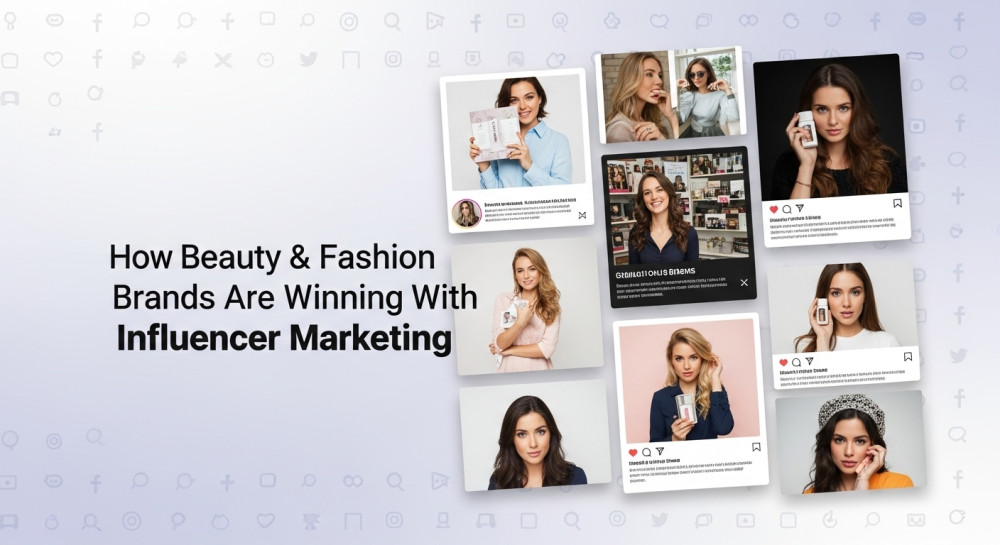How Beauty & Fashion Brands Are Winning With Influencer Marketing
As all of you have observed across the social media platforms every time fashion and beauty influencers often come on your screen every time. Do you know the reason behind this?
Fashion influencers solely dominate, accounting for approximately 61% of all influencers. This number clearly depicts why brands in these sectors dominate and invest heavily in influencer marketing.
Fashion influencers showcase their daily lifestyle, outfits, beauty, and skincare products through various content formats such as GRWM (Get Ready With Me), tutorials, reviews, skincare challenges, and more. This content directly attracts a targeted audience and leaves a lasting impression that often leads to purchase decisions.
Brands sometimes provide influencers with coupon or discount codes to share with their followers, aiming to drive higher engagement and boost sales.
Let’s explore in detail how beauty and fashion brands are winning game with influencer marketing
How Beauty And Fashion Brands Are Winning Game
Leveraging UGC Creators
User-Generated Content (UGC) creators who create sponsored videos and product showcases for brands without publishing to their own feeds have become essential. Brands use UGC for paid ads, landing pages, and social proof, giving campaigns a natural, relatable feel. The number of UGC creators grew by 93% from 2024 to 2025.
Leveraging GRWM & Tutorial Formats
“Get Ready With Me” (GRWM) and tutorial videos are the backbone of beauty and fashion influencer content. These formats naturally showcase how products fit into real-life routines whether it's a skincare step-by-step, a makeup look, or a clothing haul.
Product Launches and Collaborations
Brands like Morphe, ColourPop, and H&M are successfully co-creating products with influencers, turning them into brand collaborators rather than just promoters. These limited edition collections often generate significant buzz and sell out rapidly, offering consumers a sense of exclusivity and emotional connection to the product.
According to recent industry data, influencer-backed product launches can drive up to 40% more sales compared to traditional product rollouts. In addition, campaigns that include influencer collaborations have shown to achieve over 2x higher engagement rates than brand-only content, making this strategy both impactful and profitable.
Localized Influencer Targeting
Beauty and fashion brands are increasingly turning to regional and vernacular influencers to penetrate Tier 2 and Tier 3 markets - especially in countries like India, Indonesia, Brazil, and Vietnam. These influencers connect deeply with local audiences through native language, cultural familiarity, and region-specific aesthetics.
Studies show that localized influencer campaigns generate up to 2 times more engagement than generic national campaigns. In India, for example, regional content in Hindi, Tamil, and Marathi is significantly outperforming English-led campaigns in emerging cities.
Authenticity
Consumers in 2025 are more discerning than ever and can quickly spot scripted or inauthentic brand promotions. Beauty and fashion brands that allow influencers the freedom to express their genuine opinions are seeing stronger results. Audiences respond better to honest product experiences shared in the creator’s unique voice and personal style.
According to a Nielsen study, 92% of consumers trust influencer content more when it feels authentic, leading to significantly higher engagement, brand affinity, and repeat purchases. In a digital world saturated with content, authenticity has become a key differentiator and a driver of long-term loyalty.
Rise of AI Influencer Tools
In 2025, brands are leveraging AI-powered influencer marketing platforms like Viral Pitch to streamline influencer discovery, vet creators based on niche relevance, analyze past performance metrics, and even detect fake followers. These tools are making influencer marketing more data-driven and efficient than ever.
On average, companies using AI for influencer discovery report up to 70% reduction in planning time, along with higher campaign accuracy and improved ROI. This shift is enabling marketing teams to scale faster and focus on strategic execution rather than manual research.
Conclusion
In 2025, influencer marketing has become the driving force behind the success of many beauty and fashion brands. From personalized, creator-led content to AI-powered influencer discovery, the true advantage lies in forming authentic, data-driven partnerships with creators who genuinely connect with their audiences.


